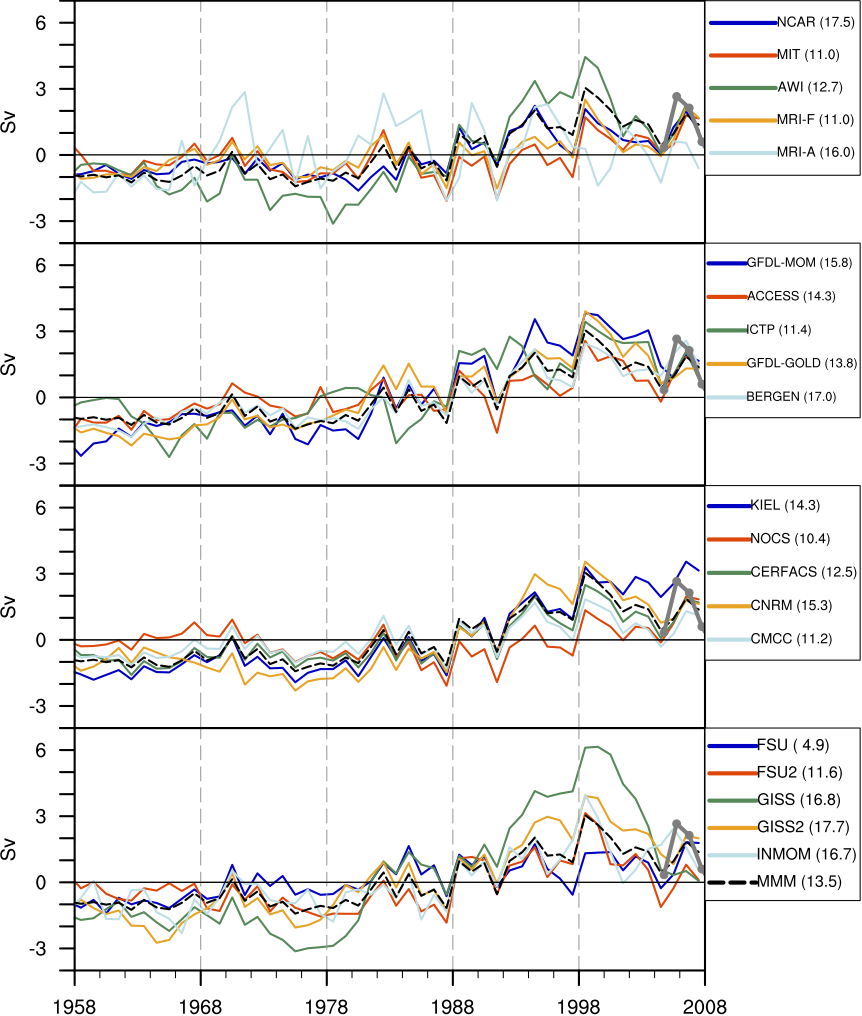AMOC and its role in long time scale climate variability and in prediction

The Atlantic meridional overturning circulation (AMOC) is presumed to play a major role in decadal and longer time scale climate variability and in prediction of the Earth's future climate on these time scales through its heat and salt transports and its impacts on sea surface temperatures (SST) and sea level. Due to a lack of long and continuous AMOC observations, the main support for such a prominent role for AMOC in influencing the earth's climate comes from coupled general circulation model (CGCM) simulations. In long control simulations with climate general circulation models (CGCMs), usually for pre-industrial conditions run without either changes in radiative forcings or inclusion of anthropogenic forcings, AMOC intrinsic variability is rather rich with a variety of time scales, e.g., inter-annual, decadal, centennial. Furthermore, such low frequency AMOC anomalies tend to precede the basin scale SST anomalies in the Atlantic Ocean, i.e., the Atlantic Multidecadal Variability (AMV), thus suggesting a driving role for AMOC in models. Unfortunately, fidelity of representation of AMOC in CGCMs remains a serious concern, and a fundamental understanding of the mechanisms of simulated AMOC variability remains elusive. To complement CGCMs and reanalysis products, forced ocean – sea-ice hindcast simulations can be used to investigate AMOC variability and its mechanisms on seasonal, inter-annual, and decadal time scales and to understand and separate forced variability from natural variability. This study presents an analysis of the simulated inter-annual to decadal variability and trends in the North Atlantic Ocean for the 1958-2007 period from a set of simulations participating in the second phase of the Coordinated Ocean-ice Reference Experiments (CORE-II), focusing on AMOC.
In general, AMOC variability shows three distinct stages (see Figure). During the first stage that lasts until the mid- to late-1970s, AMOC is relatively steady, remaining lower than its long-term (1958-2007) mean. Thereafter, AMOC intensifies with maximum transports achieved in the mid- to late-1990s. This enhancement is then followed by a weakening trend until the end of the integration period. This sequence of low frequency AMOC variability appears to be consistent with previous studies. Regarding the strengthening of AMOC between about the mid-1970s and the mid-1990s, the results support a previously identified variability mechanism where AMOC intensification is connected to increased deep water formation in the subpolar North Atlantic, driven by the North Atlantic Oscillation-related surface fluxes. The simulations tend to show general agreement in their representations of, for example, AMOC, SST, and subpolar mixed layer depth variability. In particular, the observed variability of the North Atlantic SSTs is captured well by all models. These findings indicate that simulated variability and trends are primarily dictated by the atmospheric datasets which include the influence of ocean dynamics from nature superimposed onto anthropogenic effects. Despite these general agreements, there are many differences among the model solutions, particularly in the spatial structures of variability patterns. For example, the location of the maximum AMOC variability differs among the models between Northern and Southern Hemispheres.
Written by Gokhan Danabasoglu

Figure Caption: AMOC annual-mean maximum transport time series at 26.5°N for the 1958-2007 period from the last cycle of simulations from twenty participating models. The time series are anomalies from the respective 50-year means given for each model in parentheses in the labels. The thick gray lines represent the annual-mean RAPID data from Cunningham et al. (2007). The 4-year mean for the RAPID data is 18.6 Sv. Multi-model mean (MMM) time series are included in all panels as the dashed black lines.













